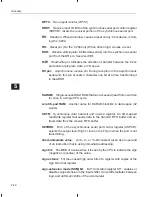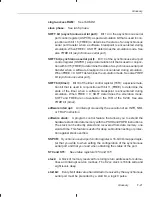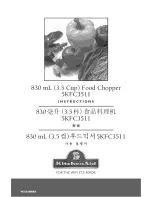
F-6
current data page:
The data page indicated by the content of the data page
pointer (DP). See also
data page; DP.
D
D0–D15:
Collectively, the external data bus; the 16 pins are used in parallel
to transfer data between the ’C2xx and external data memory, program
memory, or I/O space.
DARAM:
Dual-access RAM. RAM that can be accessed twice in a single
CPU clock cycle. For example, your code can read from and write to DA-
RAM in the same clock cycle.
DARAM configuration bit (CNF):
See
CNF bit.
data-address generation logic:
Logic circuitry that generates the address-
es for data memory reads and writes. This circuitry, which includes the
auxiliary registers and the ARAU, can generate one address per ma-
chine cycle. See also
program-address generation logic.
data page:
One block of 128 words in data memory. Data memory contains
512 data pages. Data page 0 is the first page of data memory (addresses
0000h–007Fh); data page 511 is the last page (addresses
FF80h–FFFFh). See also
data page pointer (DP); direct addressing.
data page 0:
Addresses 0000h–007Fh in data memory; contains the
memory-mapped registers, a reserved test/emulation area for special in-
formation transfers, and the scratch-pad RAM block (B2).
data page pointer (DP):
A 9-bit field in status register ST0 that specifies
which of the 512 data pages is currently selected for direct address gen-
eration. When an instruction uses direct addressing to access a data-
memory value, the DP provides the nine MSBs of the data-memory ad-
dress, and the instruction provides the seven LSBs.
data-read address bus (DRAB):
A 16-bit internal bus that carries the ad-
dress for each read from data memory.
data read bus (DRDB):
A 16-bit internal bus that carries data from data
memory to the CALU and the ARAU.
data-write address bus (DWAB):
A 16-bit internal bus that carries the ad-
dress for each write to data memory.
data write bus (DWEB):
A 16-bit internal bus that carries data to both pro-
gram memory and data memory.
Glossary
















































